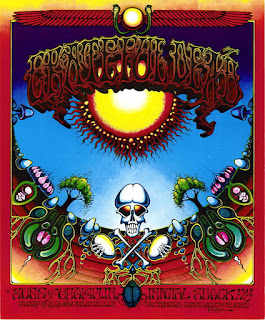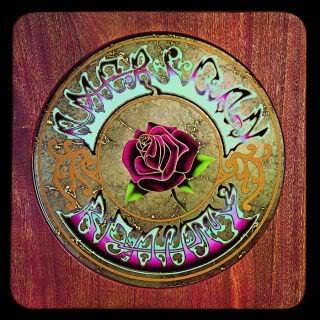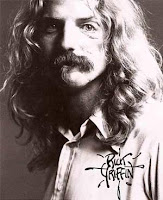Grateful Dead Live at Boston Music Hall on 1971-12-01
Collection: : GratefulDead
Band/Artist: Grateful Dead
Date: December 1, 1971 (check for other copies)
Venue: Boston Music Hall
Location: Boston, MA01.
Crytical Envelopment 02. Drums 03. The Other One 04. My and My Uncle 05. The Other One 06. Not Fade Away 07. Going Down the Road Feeling Bad
08. Not Fade Away
Who are the Grateful Dead?
The Grateful Dead were an American rock band, which was formed in the mid 1960s in San Francisco from the remnants of another band, Mother McCree's Uptown Jug Champions
The Grateful Dead were an American rock band, which was formed in the mid 1960s in San Francisco from the remnants of another band, Mother McCree's Uptown Jug Champions.
The Grateful Dead have an unbelievable repertoire under their belt with 36,504 Songs
2,318 Shows, and 30 Years in the music business! Thius i believe is most probably second to no other band in the history of music as far as i know.
The Grateful Dead are in all senses of the word a Live Band; always were and always will be. It is held for a fact by all Dead fans and even the members of the band themselves, that their best music was always performed live. Luckily, the Dead are the most recorded band in Music History, and so we have a massive array of live recorded performances on Archive.
Biography of the Grateful Dead
In 1965 the band made the stylistic switch from folk music to rock music, with Jerry Garcia, Ron Pigpen McKernan and Bob Weir from the Jug Champions joined by Bill Kreutzmann and Phil Lesh, and in 1967 - the band's breakthrough year - another percussionist, Mickey Hart.
Playing originally as The Warlocks, and later "The Grateful Dead" (a name inspired by the Egyptian Book of the Dead), they became the de facto resident band of Ken Kesey's Merry Pranksters, with the early sound heavily influenced by Kesey's LSD-soaked Trips Festivals. This early period is covered in Tom Wolfe's "The Electric Kool-Aid Acid Test." Their musical influences varied widely with input from the psychedelic music of the era, combined with rhythm and blues, jazz, and country. These various influences were distilled into a unique new music that was a synthesis of all American folk music forms to-date; it paid homage to previous forms, and also reflected a sense of adventure and a continuous quest for the "musical unknown"; more often than not, exploration and a search for continual newness were the hallmarks of their live performances.
The early records reflected their live repertoire -- lengthy instrumental jams with guitar solos by Garcia, best exemplified by "Dark Star" -- but lacked the energy of the shows and did not sell terribly well. The 1970s live album Live Dead did capture more of their essence, but commercial success did not come until the country influence came through, on American Beauty and Workingman's Dead, both released in 1970. These records featured the band's laid-back acoustic musicianship and more traditional song structures.
Jerry Garcia played lead guitar and Phil played bass guitar. Bob (usually referred to as "Bobby"), the youngest member of the group, played rhythm guitar. Pigpen played keyboards, harmonica and was an inspirational vocalist until his death in 1973. Both Bill and Mickey played drums, and a wide variety of other percussion instruments. Mickey took an extended leave of absence from 1970 to 1975. Tom "TC" Constanten also played keyboards in 1968-1970. In 1971, Keith Godchaux followed TC on the keyboards - appearing alongside Pigpen on tour. Keith brought his wife Donna Godchaux as a vocalist. Keith and Donna left the band in 1979, and Brent Mydland joined as keyboardist. Brent was the keyboardist until his death in 1990. Without missing a show, Vince Welnick and Bruce Hornsby joined as keyboardists. Vince stayed with the band until 1995. Bruce left in 1992.
Touring was the hallmark of the Grateful Dead. With the exception of 1975, the Grateful Dead toured regularly around the USA from the winter of 1965 until July 9, 1995 - with a few detours to Canada and Europe (see Dick's Picks 7, Hundred Year Hall, Steppin' Out with the Grateful Dead, and Europe '72) and 3 nights at the Great Pyramid of Giza in Egypt in 1978. Their numerous studio albums were generally collections of new songs that had been initially played in concert. The band was famous for their extended jams, which showcased both individual improvisation as well as a singularly unique "group-mind" improvisation where each of the band members improvised individually, while still blending together as a cohesive musical unit, often engaging in extended improvisational flights of fancy. A hallmark of their concert sets were continuous sets of music where each song would blend into the next (a segue).
Many of their fans, commonly referred to as Dead Heads, would follow the band on tour. In contrast to many other bands, the Grateful Dead encouraged their fans to tape their shows. For many years, almost all of their shows would have dedicated taping sections. The band allowed sharing of tapes of their shows, as long as no profits were made on the sale of their show tapes.
Starting in 1991 the they has released numerous live concerts from their archives in two concurrent series: the From the Vault releases are multi-track remixes, whereas the Dick's Picks series are based on two-track mixes made at the time of the recording. There have been at least 28 DP releases as of April 2003. Then a series of videos began to trickle out of "The Vault" starting with View From the Vault (recorded in Pittsburgh on July 8, 1990 at Three Rivers Stadium) and Another View from the Vault (recorded in Washington, DC on June 14, 1991 at RFK Stadium.) All three series of releases continue to this day.
Franklin's Tower (Grateful Dead)
Following Garcia's passing in 1995, the remaining members formally decided to disband and pursue various solo projects: most notably Bob Weir's Ratdog, Phil Lesh and Friends and Mickey Hart's music for the 1996 Olympics. Bob, Bill, Phil and Mickey reunited in mid-2002 as The Other Ones, and embarked on a fall tour throughout the eastern half of the U.S. On February 14, 2003, reflecting the reality what was, they renamed themselves The Dead, keeping 'Grateful' retired out of respect for Jerry. The adventure continues...
(source; The Grateful dead Lyrics.Com )
Here are some further playlists and downloads of the Dead for your listening enjoyment- Listen using the playlist or click on the song title of each song to download to your PC
Grateful Dead Live at Madison Square Garden on 1994-10-15 (October 15, 1994)
Band/Artist: Grateful Dead
Date: October 15, 1994 (check for other copies)
Venue: Madison Square Garden
Location: New York , NY
Click on songs below if you wish to download as an MP3
Grateful Dead Album Art
Apart from Great Album Art, The band was famous for it's ultra pychedelic poster art mad by Rick Griffin, whose amazingly cosmic and imaginative art has influenced and permeated the Psychedelic "head" comic scene more than any other artist ever. Rick Griffin has designed album covers for numerous bands of the sixties and seventies. Rick was also active making surf art in the most psychedelic manner
Bio;
Richard Alden Griffin (June 18, 1944 - August 18, 1991) was an American artist and one of the leading designers of psychedelic posters in the 1960s. He was also a contributor to the underground comix movement whose work appeared regularly in Zap Comix Griffin was closely identified with the Grateful Dead, having designed some of their best known posters and record jackets. He was also known for his work within the surfing subculture, including his comic strip about a surfer named "Murphy".
Griffin was born near Palos Verdes amidst the surfing culture of southern California. After attending high school, he worked on the staff of Surfer magazine where he created his surfing comic strip. In Los Angeles, Griffin met a group of artists and musicians known as the Jook Savages and participated in the Watts Acid Test held by Ken Kesey.
After seeing the psychedelic rock posters that were being designed by Stanley Mouse and Alton Kelly, Griffin and the Jook Savages decided to move to San Francisco in the fall of 1966, where he designed posters in the living room of his home on Elsie Street in the Bernal Heights district. His first art exhibition was for the Jook Savages, but organizers for the Human Be-In saw his work and asked him to design a poster for their event in January 1967. Chet Helms was also impressed by Griffin's work and asked him to design posters for the Family Dog parties at the Avalon Ballroom, which led Griffin to create concert posters for The Charlatans. Eventually, a poster distribution agency by the name of Berkeley Bonaparte hired Griffin, where he teamed up with the leading poster artists of the 1960s.
In 1991, Rick Griffin was killed in a motorcycle accident in Petaluma, California. (source; Rick Griffin Ink)
Rick Griffin related Links;
Warriors Wake - By Steve Barilotti 1991 Beautiful Pandemonium - By Steve Barilotti 2003
Rick Griffin Biography - By Tim Stephenson Heart and Torch: Rick Griffin's Transcendence
The Grateful Dead and it's Members;
Lead guitarist Jerry Garcia was often seen both by the public and the media as the leader or primary spokesperson for the Grateful Dead, but was reluctant to be perceived that way, especially since he and the other group members saw themselves as equal participants and contributors to their collective musical and creative output.
Garcia, a native of San Francisco, grew up in the Excelsior District. One of his main influences was bluegrass music, and Garcia also performed—on banjo, one of his other great instrumental loves, along with the pedal steel guitar—in the bluegrass band Old and in the Way with mandolinist David Grisman.
Classically trained trumpeter Phil Lesh played bass guitar. Bob Weir, the youngest original member of the group, played rhythm guitar. Ron "Pigpen" McKernan played keyboards and harmonica and was also a group vocalist until shortly before his death in 1973 at the age of 27. All of the previously mentioned Grateful Dead members shared in vocal performance of songs. Bill Kreutzmann played drums, and in September 1967 was joined by a second drummer, New York native Mickey Hart, who also played a wide variety of other percussion instruments. Hart quit the Grateful Dead in February 1971, leaving Kreutzmann once again as the sole percussionist. Mickey Hart rejoined the Grateful Dead for good in October 1974. Tom "TC" Constanten was added as a second keyboardist from 1968 to 1970, while Pigpen also played various percussion instruments and sang.
Watch the Grateful dead playing "Ripple"
After Constanten's departure, Pigpen reclaimed his position as sole organist. Less than two years later, in late 1971, Pigpen was joined by another keyboardist, Keith Godchaux, who played grand piano alongside Pigpen's Hammond B-3 organ. In early 1972, Keith's wife, Donna Jean Godchaux, joined the Dead as a backing vocalist.
Following the Grateful Dead's "Europe '72" tour, Pigpen's health had deteriorated to the point that he could no longer tour with the Dead. His final concert appearance was June 17, 1972 at the Hollywood Bowl, in Los Angeles; he died in March, 1973.
Keith and Donna Jean left the band in 1979, and Brent Mydland joined as keyboardist and vocalist. The Godchauxs then formed the Heart of Gold Band before Keith Godchaux died in a car accident in 1980. Mydland was the keyboardist for the Grateful Dead for 11 years until his death by narcotics overdose in July 1990,becoming the third Dead keyboardist to pass away. Almost immediately, Vince Welnick, former keyboardist for The Tubes, joined on keyboards and vocals. Welnick stayed with the band until Garcia's death, but he was never a member of the Other Ones or the Dead. Welnick died on June 2, 2006, reportedly a suicide.The singer-songwriter Bruce Hornsby never officially joined the band, because of his other commitments, but he did play keyboards at most Dead shows between September 1990 and March 1992, and sat in with the band over one hundred times in all between 1988 and 1995.
Robert Hunter and John Perry Barlow were the band's primary lyricists. Owsley "Bear" Stanley was the Grateful Dead's soundman for many years; he was also one of the largest suppliers of LSD. Eleven members of The Grateful Dead were inducted into the Rock and Roll Hall of Fame in 1994, and Bruce Hornsby was their presenter.
Formation of the Grateful Dead
The Grateful Dead began their career as The Warlocks, a group formed in early 1964 from the remnants of a Palo Alto jug band called Mother McCree's Uptown Jug Champions.
According to the database on the official website, Dead.net, the band's first show was at Magoo's Pizza in suburban Menlo Park, California on May 5, 1965. They were still known as the Warlocks at the time,
The show was not recorded and not even the set list has been preserved. The band changed its name after finding out that another band of the same name had signed a recording contract. The first show under the new name Grateful Dead was in San Jose, California on December 4, 1965, at one of Ken Kesey's Acid Tests. Earlier demo tapes have survived, but the first of over 2,000 concerts known to have been recorded by the band's fans was a show at the Fillmore Auditorium in San Francisco on January 8, 1966.
The charter members of the Grateful Dead were: banjo and guitar player Jerry Garcia, guitarist Bob Weir, bluesman organist Ron "Pigpen" McKernan, the classically trained bassist Phil Lesh and drummer Bill Kreutzmann (who then used the stage name Bill Sommmers.)[24] Lesh was the last member to join the Warlocks before they became the Grateful Dead: he replaced Dana Morgan Jr. who had played bass for a few gigs. With the exception of McKernan, the core of the band stayed together for 30 years, until Garcia's death in 1995.
Grateful Dead Live at Nashville Municipal Auditorium on 1978-12-16 (December 16, 1978)
Choosing a name
The name Grateful Dead was chosen from a dictionary. According to Phil Lesh, in his biography (pp. 62), "...Jer[ry Garcia] picked up an old Britannica World Language Dictionary...[and]...In that silvery elf-voice he said to me, 'Hey, man, how about the Grateful Dead?'" The definition there was "the soul of a dead person, or his angel, showing gratitude to someone who, as an act of charity, arranged their burial." According to Alan Trist, director of the Grateful Dead's music publisher company Ice Nine, Garcia found the name in the Funk & Wagnalls Folklore Dictionary, when his finger landed on that phrase while playing a game of "dictionary". In the Garcia biography, Captain Trips, author Sandy Troy states that the band was smoking the psychedelic DMT at the time. The term "Grateful Dead" appears in folktales of a variety of cultures.
In the summer of '69, Phil Lesh told another version of the story to Carol Maw, a young Texan visiting with the band in Marin County who also ended up going on the road with them to the Fillmore East and Woodstock. In this version, Phil said, "Jerry found the name spontaneously when he picked up a dictionary and the pages fell open. The words 'grateful' and 'dead' appeared straight opposite each other across the crack between the pages in unrelated text." [grateful | dead]
A new Type of sound
The Grateful Dead formed during the era when bands like The Beatles and The Rolling Stones were dominating the airwaves. "The Beatles were why we turned from a jug band into a rock 'n' roll band," said Bob Weir. "What we saw them doing was impossibly attractive. I couldn't think of anything else more worth doing" Former folk-scene star Bob Dylan had recently put out a couple of records featuring .....
Continue reading this at Wikipedia....
http://en.wikipedia.org/wiki/Grateful_Dead#A_new_type_of_sound
Interesting and Useful Links
Deadheads for Obama Live Grateful dead Music dot com Grateful dead Artwork by Rick Griffin
Rick Griffin Official Homepage Grateful Dead Official homepage Archive of Grateful Dead Music





























































